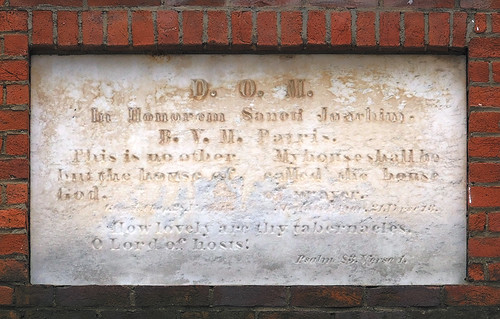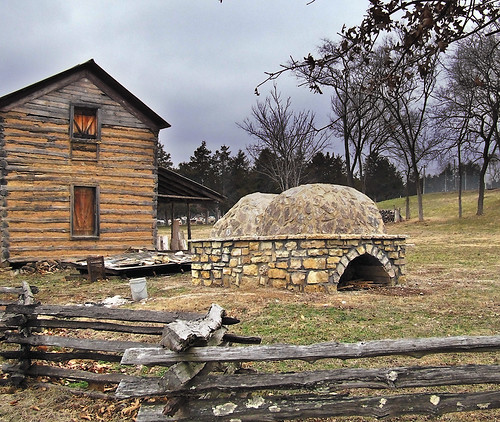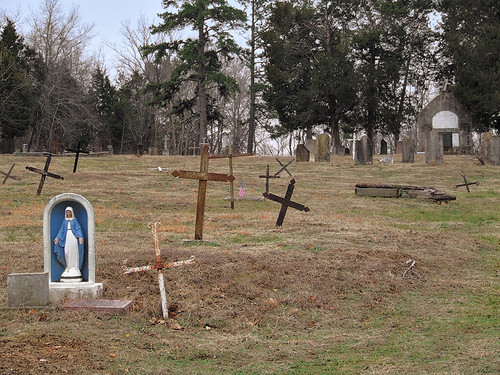
The patron of this church is Saint Joachim, father of Mary, who has a great devotion among the Catholic French; and nearby is a church named after his wife, Saint Anne. "And Joachim said: Now I know that the Lord has been gracious unto me, and has remitted all my sins." — Protoevangelium of James.
[These photos, taken January 13th, 2008, aren't very good; it was such a dreary day.]
By the time of this parish's founding in the early 19th century, French settlement in this area had been well-established for over a century. According to Carroll's Corner genealogical website's history of Old Mines:
Saturday(Vigil): 4:00 p.m.
Sunday: 8:00 a.m., 10:30 a.m.
M, Tu, W, F: 8:15 a.m.
Thursday: 7:00 p.m.
[These photos, taken January 13th, 2008, aren't very good; it was such a dreary day.]
By the time of this parish's founding in the early 19th century, French settlement in this area had been well-established for over a century. According to Carroll's Corner genealogical website's history of Old Mines:
"In 1719 Sieur de Renaudiere conducted mining operations in the vicinity of the Meramec Valley, Big River and Washington County. He was sent here by the Company of the Indies but was unsuccessful in his mining efforts because he had no skilled workers.
"Also in 1719 Philip Francois Renault left France for Upper Louisana (Missouri) bringing with him supplies and numerous skilled miners. On the way he stopped at San Domingo and purchased numerous slaves to work the mines. These were the first slaves to be brought to Missouri. Renault's expedition was near the site of the first Ft. De Chartres, Illinois and Kaskaskia in 1720. He came to the mineral area of Missouri where he began mining operations at Mine La Motte and in 1723 Renault received a grant for one and one-half leagues of land in the area which is now Washington County. (It is believed that the "Cabanage de Renaudiere" mentioned in this grant indicates an even earlier settlement at Old Mines.) Mining operations continued for years along Big River, Mineral Fork & Fourche Renault creeks. Then leaving behind some of his workmen Renault went back to Illinois for several years before he returned to France in 1742.
"A trail was cut from the mines to the Mississippi River and at first lead was taken to the river on pack-animals. When carried by pack-horses, the lead, instead of being moulded into "pigs" was moulded into the shape of a collar & hung across the horses neck. Later the lead was transported on two-wheeled French carts called charrettes. The lead was then taken across the river to Ft. DeChartres where it was weighed, measured and prepared for shipping to New Orleans. Eventually the town of Ste. Genevieve was established on the Missouri side of the river for this purpose. Lead from the mines was now taken to this site & shipped down the river to New Orleans on keel or flatboats. From New Orleans it was shipped to France.
"Old Mines Grant - This grant lies in townships 38 & 39 north & in ranges 2 & 3 east & contains 10, 548 acres. It was conceded to a number of individuals, jointly, on the 4th of Jan. 1803, by Spanish authority. Afterward 31 individuals, most of whom were settlers thereon, received a confirmation of the grant from Congress. Among the early settlers of this tract were: P.P. Boyer, Wm. C. Carr, John B. Portell, Pierce Martin, Jacob Boise, A. Diclos [Duclos], Charles P. Robert [Robart], Joseph Pratt, B. St. Gemme, Widow Coleman, Joseph Boyer, Charles Boyer, Nicholas Bouelvian, F.B. Valle, Jaque Gibbourd, Joseph Bequette, Bernard coleman & perhaps others. No doubt many of these men lived on their lands many years before they obtained concession rights from the Spanish government.........."
The architectural firm of Kromm Rikimaru and Johansen Inc. has an online research project of distinctive architecture of this region. According to this history:

This stone is above the entrance to the church.
In Honor of Saint Joachim.
Father of the Blessed Virgin Mary.
"The Old Mines church began as a mission church to Ste. Genevieve, being served first by Father Maxwell, and then in 1814, by Henri Pratte. Father Francis Xavier Dahmen from Ste. Genevieve began serving the mission church in 1821. Father Jean Bouillier, C. M., from Perryville, began serving there in 1826 after his ordination, and in 1828 he became the first permanent pastor, when the parish was separated from Ste. Genevieve.Washington County was established in 1813 from territory taken from Sainte Genevieve County, and is named after Founding Father George Washington.
"In 1828, he started the brick church, commissioning Obadiah Freeman to supervise making the bricks from clay from Adrian Coleman's land grant. Bouillier left to travel to the mother house in Paris, France in 1830, and the church was finished by Father Philip Borgna, C.M., and consecrated by Bishop Joseph Rosati on October 9, 1831. In 1833, Bouillier returned from France to take back his position at St. Joachim. This brick church is constructed with "Palledian" detail". The original floor plan was 30 feet by 110 feet, with a 50 foot high steeple.
"The first Diocesan Priest, John Cotter, who was trained in Perryville, took over in 1841. Father Cotter, killed in a fall from a horse in 1851, is buried in a brick tomb under the floor of the church to the left of the stairs; a bronze marker was added on his tomb location in 1995. Apparently this was a common risk for the priests who had to travel out to various mission chapels for Father John J. McCaffery of nearby Richwoods, was also killed when he was thrown from a horse in 1856.
"Father James Fox took over the parish after Cotter was killed, and served until 1868. He over saw an enlargement and modification of the floor plan of the church in 1852 to 1857, adding the wings and enlarging the rectangular steeple. These modifications were capped off with the purchase of the cast steeple bell of 960 lbs., for $351.30, by Mary Lewis Lamarque in 1858. A visit to the attic shows the original 1850s wood shingles nailed to hewn and pegged roof truss members. The 19th century church had pairs of chimneys on either side, for stoves used to heat the building.
"The church was renovated at least three times in the 20th century: once in about 1900, once in 1945, and the last time in the 1960s. During the 1945 restorations, the chimneys were removed, but the original stone altar was restored. Father Fox was also responsible for building the first school and establishing the first lending library in Old Mines."

This stone is above the entrance to the church.
D.O.M.D.O.M. = Latin: Deo Optimo Maximo; for God, the Best and Greatest
In Honorem Sancti Joachim.
B.V.M. Patris.
In Honor of Saint Joachim.
Father of the Blessed Virgin Mary.
This is no other but the house of God. Genesis 28. Verse 17.
My house shall be called the house of prayer. Isaias 56. Verse 7.
How lovely are thy tabernacles, O Lord of Hosts! Psalm 83. Verse 1.

Below the hill from the church are a number of old buildings of various styles of the colonial and pioneer periods. Here we see a stone kiln or oven.
As late as the 1980s, according to musician Dennis Stroughmatt (who plays the traditional fiddle), there were nearly a thousand native French speakers in the greater Old Mines region. According to an interview:

Saint Joachim's cemetery has numerous wrought iron cross-shaped monuments. According to the Old Mines Area Historical Society, the common surnames found in the Old Mines region include:
Mass times:As late as the 1980s, according to musician Dennis Stroughmatt (who plays the traditional fiddle), there were nearly a thousand native French speakers in the greater Old Mines region. According to an interview:
Old Mines is, in the technical sense, it's a small village on Route 21 North of Potosi, Missouri, about 45 to 50 miles due west of Ste. Genevieve. That kind of gives you a geographic location. But really, Old Mines is much, much bigger than just the small village. The small village is maybe 20 houses, you know, and the St. Joachim church and school. But the Old Mines region itself is anywhere from 40 to 50 miles square. Because that's what the locals call it, they call it the Old Mines district, which is a combination of the mines of Cadet, Mine à Breton (Potosi), and Mine Renault (the Renault mine). All the way basically from Potosi up to just south of Desoto is considered by the locals to be Old Mines. And in this area there have been French miners who have mined originally lead, for the king of France, and then tiff [barite], a chalky white substance that is the base of lead paint. And it basically, you find it concurrent with lead, in lead veins, and it was something they were able to continue to do independently. And this independence allowed them, in many way--because of their isolation in the Ozarks--the independence of being miners has allowed them to continue their language, continue their culture, their music. Whereas cousins of theirs, ancestors who may have originally been in Vincennes, or, some of them were originally in Prairie du Chien, Wisconsin, others in Peoria, Illinois, some in Belleville, some in Cahokia. Many moved across the river to Ste. Genevieve, St. Louis, you know, Florissant, St. Charles. But then as the Americans, the English, the Germans started approaching, it was only the very few, wealthier families, who actually stayed along the Mississippi River, directly along the Mississippi. Of course, there are French families still there, but it was the largest groups that moved west into places like Potosi, Old Mines, Desoto, and Festus, because there was such an intensive French population there.Stroughmatt says that Saint Joachim Church was the center of the community and kept the French culture alive. However, widespread conscription during World War II started changing the culture, due to the many young men leaving the Old Mines area. But French culture remains even today in both local architectural customs, and in the traditional music of the area:
"....one good example is the song La Guillanée, which is the New Year's song. Now there's a song that has medieval connotations to it. It actually comes from a pagan ritual, in a sense. Even pre-Catholic church, because of it's idea, some say that it dates to the medieval period. But the thing about it is, it is known that it came from northern France--from Normandy, Brittany, from the very Celtic region for France--and that there is a ceremony, an event very similar to it in Scotland and in Ireland, called the Hogmanay, that happens around New Year's, when they sing a song that is similar to the Guillanée. A lot of it is about a time of the year, of being charitable and giving. And that's in the song, and also revelry, being happy, dancing, and a lot of this is in response to wintertime. You know, the fact that it's a very dark time of the year. And this is a way to sort of combat that, to combat the spirits of the year, and to combat the human spirit that becomes so depressed. Parts of this song are actually known in Louisiana, too."

Saint Joachim's cemetery has numerous wrought iron cross-shaped monuments. According to the Old Mines Area Historical Society, the common surnames found in the Old Mines region include:
Archambeau, Aubuchon, Auge, Beauline, Becquet, Bequette, Boeuf, Bonneau, Bourassau, Boyer, Caillot, Charbonneau, Coleman, Courtois, DeGagne, Degonia, Duclos, Govereau, Hamlin, Higginbotham, Juliette, Jullerat, Lachance, Lalumondiere, Lamarque, LaSource, Mallet, Maurice, Mercille, Mesplay, Missey, Mundy, Pashia, Pepin, Pratt, Robert dit Politte, Rouleau, Roussin, Sansoucie, Tanque, Troquet, Theabeau, Trudeau, Valle, and Villmer.
Saturday(Vigil): 4:00 p.m.
Sunday: 8:00 a.m., 10:30 a.m.
M, Tu, W, F: 8:15 a.m.
Thursday: 7:00 p.m.
Confessions:
Saturday 3:30 p.m. - 4:45 p.m.
Adoration:


This a wonderful historic parish and a beautiful little church. I have visited many times. There is much to see, including the beautiful old cemetery. Stay for Mass or stop and say some prayers. It is not to far south on Hwy.21 from Washington State Park.
ReplyDeleteThere should be a huge push to get this property on the National Registry of Historic Places...it is long overdue.
ReplyDelete